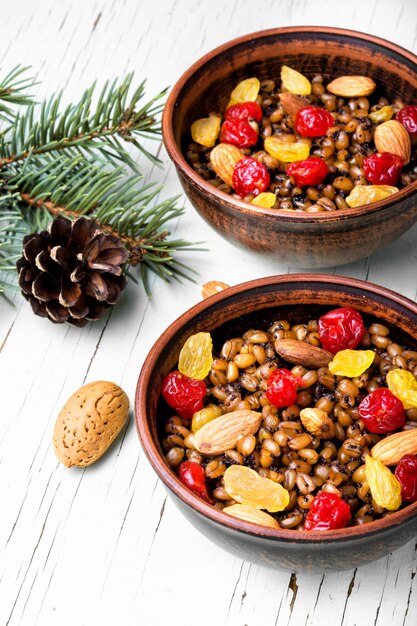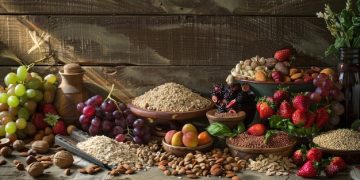Boost Your Digestion with 7 High-Fiber Foods Daily

Incorporating high-fiber foods into your daily diet is crucial for optimizing digestive health, preventing constipation, and supporting overall gut well-being, contributing to a more comfortable and efficient bodily system.
Are you seeking a natural and effective way to enhance your digestive health? The answer may lie in your kitchen cabinet and grocery cart. Understanding the power of fiber, we delve into 7 High-Fiber Foods You Should Be Eating Daily for Better Digestion, offering practical advice and insights to transform your dietary habits for improved gut wellness.
The Indispensable Role of Fiber in Digestive Health
Fiber, often hailed as the cornerstone of a healthy digestive system, plays a far more intricate role than simply aiding regularity. It is a complex carbohydrate that the body cannot digest, meaning it passes relatively intact through the stomach and intestines. This indigestible quality is precisely what makes it so beneficial. Fiber comes in two main forms: soluble and insoluble, each contributing uniquely to our well-being.
Soluble fiber, found in foods like oats, beans, and certain fruits, dissolves in water to form a gel-like substance. This gel helps to slow down digestion, which can be particularly advantageous for managing blood sugar levels and lowering cholesterol. By forming a viscous mass, soluble fiber contributes to a feeling of fullness, aiding in weight management by reducing overall calorie intake. It also serves as a prebiotic, fermenting in the large intestine and feeding beneficial gut bacteria.
Insoluble fiber, prevalent in whole grains, vegetables, and nuts, does not dissolve in water. Its primary function is to add bulk to stool and help food pass more quickly through the digestive tract. This accelerates the transit time of waste materials, preventing constipation and promoting regular bowel movements. The physical presence of insoluble fiber helps to keep the intestinal walls clean and lessens the risk of diverticular disease. A diet rich in both types of fiber ensures a synergistic effect, providing comprehensive digestive support and guarding against common gastrointestinal discomforts.
Understanding Daily Fiber Targets
Many people struggle to meet their recommended daily fiber intake, often due to a reliance on processed foods that have been stripped of their natural fiber content. The average adult in the United States consumes significantly less fiber than what is advised.
* For women: The recommended daily intake is approximately 25 grams.
* For men: The recommendation rises to about 38 grams per day.
* For children: Fiber needs vary by age, generally starting lower and increasing with growth.
These targets might seem challenging at first, but with a conscious effort to integrate fiber-rich foods into every meal, achieving them becomes much more manageable. Meeting these targets is not just about avoiding constipation; it’s about fostering a thriving gut microbiome, which in turn influences immune function, mood, and overall systemic health. A consistent intake of adequate fiber can significantly reduce the risk of chronic diseases such as heart disease, type 2 diabetes, and certain cancers.
The Broader Benefits Beyond Digestion
While digestive health is a primary advantage, the benefits of a high-fiber diet extend far beyond the gut. The slow absorption of sugars associated with soluble fiber helps in maintaining stable blood glucose levels, a critical factor for individuals with or at risk of type 2 diabetes. Furthermore, soluble fiber binds to cholesterol particles in the digestive tract, preventing their absorption and thereby contributing to healthier cholesterol levels and improved cardiovascular health. Its ability to create bulk in the stomach and intestines also promotes satiety, making it an invaluable tool for weight management. Regular fiber intake helps in feeling fuller for longer periods, reducing the urge to snack unnecessarily and aiding in calorie control.
Berries: Small but Mighty Fiber Powerhouses
Berries, celebrated for their vibrant colors and sweet-tart flavors, are truly unsung heroes in the realm of high-fiber foods. Beyond their appeal to the palate, these tiny fruits pack a significant nutritional punch, particularly when it comes to fiber content. They are an effortless addition to almost any meal, transforming simple dishes into nutrient-dense powerhouses.
Among the various types, raspberries stand out with an impressive 8 grams of fiber per cup, making them one of the most fiber-dense fruits available. Blackberries come in close behind with about 7.6 grams per cup, followed by blueberries and strawberries, which offer around 3 to 4 grams per cup. This diverse range ensures that you can always find a berry to suit your taste and dietary needs. The fiber in berries is a mix of both soluble and insoluble types. The soluble fiber contributes to a feeling of fullness and helps stabilize blood sugar, while the insoluble fiber aids in promoting regular bowel movements, making them invaluable for digestive regularity.
Incorporating berries into your daily routine is incredibly simple. They can be added to breakfast cereals, oatmeal, or yogurt for an immediate fiber boost. Blending them into smoothies is another popular method, ensuring you get all their benefits in a convenient, portable form. For a healthy snack, a handful of fresh or frozen berries can satisfy sweet cravings while contributing significantly to your daily fiber intake. They also excel in baked goods, creating healthier versions of muffins, pancakes, and desserts. Their versatility means they can be enjoyed year-round, either fresh during their season or frozen for convenience.
Nutrient Profile of Berries
Beyond their admirable fiber quota, berries are brimming with essential vitamins, minerals, and antioxidants. These compounds play a vital role in protecting your cells from damage caused by free radicals, potentially reducing the risk of chronic diseases. Strawberries, for instance, are exceptionally rich in Vitamin C, a powerful antioxidant that supports immune function and skin health. Blueberries are renowned for their high concentration of anthocyanins, which are potent antioxidants linked to improved brain health and reduced inflammation. Raspberries and blackberries contribute valuable manganese and Vitamin K, essential for bone health and blood clotting.
Practical Ways to Incorporate Berries
There are countless ways to enjoy berries and reap their fiber benefits. Beyond breakfast and smoothies, consider adding them to salads for a burst of flavor and texture. They pair wonderfully with spinach, goat cheese, and walnuts. For a light dessert, a simple bowl of mixed berries with a dollop of Greek yogurt can be both satisfying and nutritious.
* Breakfast Booster: Sprinkle fresh berries over your morning oatmeal, Greek yogurt, or whole-grain pancakes.
* Smoothie Sensation: Blend frozen berries with a banana, spinach, and almond milk for a quick, fiber-rich drink.
* Salad Enhancer: Add a handful of berries to your lunch salad for a touch of sweetness and extra nutrients.
* Healthy Snack: Enjoy a bowl of mixed berries as a standalone snack between meals.
* Dessert Delight: Use berries in homemade fruit tarts, parfaits, or a simple Berry compote.
Legumes: The Versatile Fiber Champions
Legumes, encompassing beans, lentils, chickpeas, and peas, are foundational components of a healthy diet, particularly recognized for their exceptional fiber content. These plant-based powerhouses are not only affordable and widely available but also incredibly versatile, lending themselves to a vast array of culinary applications. Their unique nutritional profile, rich in both soluble and insoluble fiber, makes them indispensable for promoting a robust digestive system.
A single cup of cooked lentils, for example, delivers an astonishing 15.6 grams of fiber, while black beans boast around 15 grams per cup. Chickpeas offer about 12.5 grams, and kidney beans provide approximately 13.1 grams. This makes legumes one of the most fiber-dense food groups, far surpassing many other common food sources. The high soluble fiber content in legumes contributes to feelings of satiety and helps regulate blood sugar levels, while the insoluble fiber adds bulk to stool, ensuring efficient waste elimination and preventing constipation. This dual action supports a healthy gut microbiome, which is vital for overall health.
Legumes can be effortlessly integrated into daily meals, acting as a superb protein and fiber source for vegetarians and meat-eaters alike. They shine in hearty soups and stews, add substance and creaminess to salads, and form the base for delicious dips like hummus. Their versatility makes them perfect for meal prepping, as they store well and can be added to various dishes throughout the week. From chili to curries, and from veggie burgers to simple side dishes, legumes offer an endless canvas for culinary creativity.

Nutritional Powerhouse
Beyond fiber, legumes are packed with an impressive array of essential nutrients. They are an excellent source of plant-based protein, making them a crucial component of vegetarian and vegan diets. This protein content, combined with their complex carbohydrates, provides sustained energy release, helping to avoid energy crashes. Legumes also provide significant amounts of iron, an essential mineral for oxygen transport in the blood, and folate, vital for cell growth and DNA synthesis. Moreover, they are rich in potassium, magnesium, and zinc, all of which contribute to various bodily functions, from nerve and muscle function to immune support.
Cooking with Legumes: Tips for Success
While canned legumes offer convenience, dried varieties are often more economical and allow for greater control over sodium content. If using dried legumes, soaking them overnight can significantly reduce cooking time and improve digestibility. Beginning with smaller portions and gradually increasing intake can help the digestive system adjust to the increased fiber, minimizing potential gas and bloating.
* Soups and Stews: Add a variety of beans or lentils to your favorite soup recipes for added body, protein, and fiber.
* Salad Toppers: Rinse and drain canned chickpeas or black beans and toss them into salads for a quick, nutritious boost.
* Dips and Spreads: Mash chickpeas to make homemade hummus, or use cannellini beans for a creamy white bean dip.
* Main Dishes: Incorporate lentils into shepherd’s pie, use beans in tacos or burritos, or prepare a hearty lentil Bolognese.
Oats: More Than Just a Breakfast Staple
Oats, particularly rolled or steel-cut varieties, are often synonymous with a wholesome breakfast, and for good reason. They are an exceptional source of dietary fiber, particularly beta-glucan, a type of soluble fiber highly beneficial for digestive health and beyond. While commonly enjoyed as porridge, their versatility extends far beyond the breakfast bowl, making them a pantry staple for anyone seeking to boost their fiber intake.
A single cup of cooked oats provides approximately 4 grams of fiber, with a significant proportion being soluble fiber. Beta-glucan specifically forms a gel-like substance in the digestive tract, which helps to slow digestion, stabilize blood sugar levels, and lower cholesterol. This soluble fiber acts as a prebiotic, feeding the beneficial bacteria in the gut, which in turn supports a healthy microbiome. A balanced gut flora is crucial not only for efficient digestion but also for immune function and even mood regulation. The insoluble fiber in oats contributes to bulk in the stool, promoting regularity and preventing constipation.
Beyond their fiber prowess, oats offer a range of essential nutrients, including manganese, phosphorus, magnesium, copper, iron, and zinc. They also contain avenanthramides, unique antioxidants that have anti-inflammatory properties and may help protect against heart disease. Their natural gluten-free status (though cross-contamination can occur in processing, so certified gluten-free oats are best for those with sensitivities) makes them a valuable grain option for a broader audience.
Oats for Digestive Comfort
The soluble fiber in oats can be particularly soothing for the digestive system. By slowing the transit of food, it allows for more thorough nutrient absorption and can help regulate bowel movements, making them beneficial for both constipation and diarrhea by normalizing stool consistency. The gentle nature of oat fiber makes it a suitable choice for sensitive stomachs, providing bulk without excessive irritation.
Creative Ways to Enjoy Oats
While oatmeal might be the most common way to consume oats, don’t limit yourself. Overnight oats are a convenient and refreshing option, allowing you to prepare breakfast the night before. Oats can also be ground into flour for baking, used as a binder in meatballs or veggie burgers, or added to smoothies for extra thickness and fiber. Their subtle flavor makes them adaptable to a variety of sweet and savory dishes.
* Classic Oatmeal: Prepare with water or milk, and top with fruits, nuts, or a drizzle of honey.
* Overnight Oats: Combine rolled oats with milk, yogurt, chia seeds, and fruit in a jar, and refrigerate overnight.
* Baking Ingredient: Use oat flour in muffins, cookies, or pancakes for a fiber boost.
* Smoothie Thickener: Add a tablespoon or two of rolled oats to your morning smoothie for extra substance.
* Savory Dishes: Incorporate oats into meatloaf, veggie burgers, or as a topping for casseroles.
Avocados: The Creamy Fiber Source
Often celebrated for their healthy fats, avocados are also surprisingly rich in dietary fiber, making them an excellent addition to a daily regimen aimed at improving digestion. These creamy, nutrient-dense fruits defy traditional fruit categories, offering a unique blend of benefits that contribute significantly to gut health and overall well-being.
A single medium-sized avocado contains approximately 10 grams of dietary fiber, a remarkable amount for a fruit. What’s more, this fiber is split between soluble and insoluble types, roughly in a 1:2 ratio. The soluble fiber contributes to a feeling of fullness, helps regulate blood sugar, and supports healthy cholesterol levels. Meanwhile, the insoluble fiber adds bulk to stool, facilitating regular bowel movements and preventing constipation. This balanced fiber profile, combined with their beneficial monounsaturated fats, makes avocados a powerhouse for digestive comfort and efficiency.
Beyond fiber, avocados are packed with an impressive array of vitamins and minerals, including Vitamin K, Folate, Vitamin C, Vitamin B5, Vitamin B6, Vitamin E, and potassium. The healthy fats in avocados also aid in the absorption of fat-soluble vitamins (A, D, E, and K) from other foods eaten concurrently, further boosting their nutritional value. Their smooth, creamy texture and mild flavor make them incredibly versatile in the kitchen, easily integrated into a wide range of meals.
Digestive Benefits Amplified
The high potassium content in avocados also plays a role in digestive health by supporting fluid balance and muscle contractions, which are essential for the smooth movement of food through the intestines. The healthy fats not only aid in satiety but also help lubricate the digestive tract, potentially easing the passage of stool. This combination of fiber, healthy fats, and micronutrients positions avocados as a top contender for daily consumption to support a happy gut.
Easy Ways to Add Avocado to Your Diet
Avocados’ creamy texture makes them a fantastic substitute for less healthy fats in many recipes. They can be mashed into guacamole, sliced into salads, or simply enjoyed on toast for a quick and nutritious meal. Their versatility lends itself to both savory and sweet applications, offering endless possibilities for incorporating them into your daily eating habits.
* Avocado Toast: Mash avocado on whole-grain toast and season with salt, pepper, and chili flakes.
* Guacamole: Prepare fresh guacamole with onion, cilantro, lime juice, and a pinch of salt.
* Salad Addition: Slice or dice avocado into your favorite salads for added creaminess and nutrients.
* Smoothie Booster: Blend a quarter to half an avocado into smoothies for a rich, creamy texture and healthy fats.
* Sandwich Spread: Use mashed avocado as a healthy alternative to mayonnaise or butter in sandwiches.
Flaxseeds: Tiny Seeds with Mighty Digestive Impact
Flaxseeds, though minuscule in size, are a potent superfood renowned for their exceptional fiber content, omega-3 fatty acids, and lignans. These tiny, nutty-flavored seeds are a boon for digestive health, offering a unique combination of benefits that can significantly improve gut function and overall well-being. Their ability to expand and form a gel when mixed with liquid makes them particularly effective as a digestive aid.
Ground flaxseeds are the most beneficial form, as whole flaxseeds can pass through the digestive tract undigested, preventing the absorption of their valuable nutrients. Just two tablespoons of ground flaxseeds provide approximately 3.8 grams of fiber, combining both soluble and insoluble types. The soluble fiber component, particularly mucilage, forms a gel in the GI tract, which helps to slow digestion, promote satiety, and stabilize blood sugar levels. This gel also acts as a bulk-forming laxative, softening stool and easing its passage, making flaxseeds highly effective in preventing and alleviating constipation. The insoluble fiber adds bulk to the stool, further promoting regularity.
Beyond their fiber content, flaxseeds are one of the richest plant-based sources of alpha-linolenic acid (ALA), a type of omega-3 fatty acid crucial for heart health and reducing inflammation. They also contain lignans, plant compounds with antioxidant and estrogenic properties that have been linked to a reduced risk of certain cancers, particularly hormone-sensitive ones. Regular consumption of flaxseeds supports a healthy gut microbiome, which is essential for nutrient absorption and immune system function.
Flaxseeds in Holistic Health
The combination of fiber, omega-3s, and lignans in flaxseeds contributes to a holistic approach to health. The anti-inflammatory properties of ALA can soothe an irritated digestive tract, while the fiber helps to maintain a clean and efficient colon. Their role in lowering cholesterol and blood pressure also highlights their cardiovascular benefits, demonstrating how gut health is intrinsically linked to systemic well-being.
Simple Ways to Integrate Flaxseeds
Incorporating ground flaxseeds into your daily diet is remarkably simple. Due to their mild flavor, they can be easily added to a variety of dishes without altering the taste significantly. It is best to buy whole flaxseeds and grind them just before use to preserve their Omega-3 content and prevent oxidation.
* Smoothie Booster: Add 1-2 tablespoons of ground flaxseeds to your morning smoothie for extra fiber and omega-3s.
* Oatmeal Topping: Sprinkle ground flaxseeds over your oatmeal or yogurt.
* Baking Ingredient: Incorporate them into muffins, bread, or pancakes. They can even be used as an egg substitute (1 tablespoon ground flaxseed + 3 tablespoons water = 1 egg).
* Salad Dressing: Whisk ground flaxseeds into a vinaigrette for a slight thickening and nutrient boost.
* Cereal Enhancer: Mix into cold or hot cereals for added texture and nutrition.
Apples: The Classic Fiber-Rich Fruit
Apples, a ubiquitous and beloved fruit, often go underestimated for their profound contribution to digestive health. As one of nature’s most convenient snacks, they are readily available year-round and pack a significant fiber punch, primarily in their skin. This makes them an easy and effective choice for daily fiber intake, supporting a smoothly functioning digestive system.
A medium-sized apple with its skin on provides approximately 4 grams of fiber, a substantial amount for a single fruit. This fiber is a beneficial mix of both soluble and insoluble types. Pectin, a prominent form of soluble fiber in apples, forms a gel when mixed with water in the digestive tract. This gel helps to slow down digestion, contributing to a feeling of fullness and helping to stabilize blood sugar levels. It also acts as a prebiotic, fostering the growth of beneficial gut bacteria, which are crucial for a healthy microbiome. The insoluble fiber in apple skin, meanwhile, adds bulk to stool, facilitating regular bowel movements and preventing constipation.
Beyond fiber, apples are a good source of Vitamin C, an essential antioxidant for immune support, and various other antioxidants that help protect cells from damage. Their high water content also aids in hydration, which is vital for maintaining soft, easy-to-pass stools. The crunchiness of apples further contributes to satiety and can be a satisfying way to curb hunger between meals.
Apples and Gut Microbiome Diversity
The pectin in apples is particularly noteworthy for its role in promoting gut health. As it ferments in the colon, it produces short-chain fatty acids (SCFAs), like butyrate, which nourish colon cells and play a role in maintaining the integrity of the gut lining. This contributes to a diverse and robust gut microbiome, benefiting overall digestive efficiency and potentially influencing systemic health outcomes, including immune function and inflammation.
Versatile Ways to Enjoy Apples Daily
Apples are incredibly versatile and can be incorporated into a wide variety of meals and snacks. The key is to consume them with the skin on to maximize fiber intake. From a simple snack to a sophisticated dessert, apples offer numerous options for enhancing your daily fiber.
* Raw Snack: Simply wash and enjoy a whole apple as a convenient and satisfying snack.
* Sliced into Salads: Add thin slices of apple to green salads for sweetness, crunch, and fiber. They pair well with nuts, cheese, and grilled chicken.
* Baking: Incorporate sliced or diced apples into oatmeal, muffins, or whole-grain pancakes.
* Apple Slices with Nut Butter: Pair apple slices with a tablespoon of almond or peanut butter for a balanced snack rich in fiber, protein, and healthy fats.
* Cooked Dishes: Add apples to savory dishes like roasted vegetables or pork loin for a touch of sweetness and depth.
Leafy Greens: The Foundation of Digestive Wellness
Leafy greens, such as spinach, kale, collard greens, and Swiss chard, are often heralded as cornerstones of a healthy diet, and their significant contribution to digestive health underscores this reputation. While not as fiber-dense per gram as legumes or certain grains, their sheer volume and nutrient richness make them an indispensable part of a daily high-fiber strategy.
These vibrant vegetables are primarily rich in insoluble fiber, which acts as a natural broom for your digestive system. This type of fiber adds necessary bulk to stool, promoting efficient movement through the intestines and preventing constipation. It helps to ensure regular bowel movements, preventing the buildup of waste products that can lead to discomfort and other digestive issues. While lower in soluble fiber, the overall fiber content, combined with their high water content, makes leafy greens extremely effective in maintaining digestive regularity and comfort.
Beyond fiber, leafy greens are packed with an astounding array of vitamins, minerals, and antioxidants. They are excellent sources of Vitamin K, Vitamin A, Vitamin C, folate, magnesium, and potassium. These nutrients support various bodily functions, including bone health, immune function, and nerve signaling. The chlorophyll in leafy greens also contributes to their detoxifying properties and can aid in overall gut cleansing. Their low-calorie count means you can consume large quantities, significantly boosting your daily nutrient and fiber intake without excess calories.
Enhancing Nutrient Absorption
The diverse nutrient profile of leafy greens, coupled with their fiber content, creates an optimal environment for nutrient absorption. A healthy, regular digestive system is more efficient at extracting vitamins and minerals from the food we eat. The antioxidants in leafy greens also help to reduce inflammation in the gut, fostering an environment where beneficial bacteria can thrive, further contributing to overall digestive efficacy.
Creative Ways to Consume More Leafy Greens
The challenge for many is incorporating enough leafy greens into their daily diet. However, their mild flavor and ability to wilt down significantly mean they can be easily integrated into a wide variety of meals, often without overpowering other ingredients. From breakfast to dinner, there’s a way to sneak in these nutritional powerhouses.
* Smoothie Booster: Add a large handful of spinach or kale to your morning smoothie; the greens often blend seamlessly into fruit smoothies.
* Salad Base: Make your main meal salad based on a hearty serving of mixed greens.
* Sautéed Sides: Quickly sauté spinach, kale, or Swiss chard with garlic and olive oil for a simple, nutritious side dish.
* In Eggs: Fold chopped spinach or kale into omelets, scrambles, or frittatas.
* Pasta and Sauces: Stir chopped greens into pasta sauces, soups, or casseroles during the last few minutes of cooking.

Broccoli: The Cruciferous Digestive Aid
Broccoli, a prominent member of the cruciferous vegetable family, is a powerhouse of nutrition and an excellent source of dietary fiber crucial for promoting optimal digestive health. Its unique composition of both soluble and insoluble fiber, combined with an array of vitamins, minerals, and beneficial plant compounds, makes it an essential daily addition for anyone looking to support their gut.
A single cup of cooked broccoli provides approximately 5 grams of fiber, making it a significant contributor to your daily intake. The insoluble fiber in broccoli adds bulk to stool, which is vital for preventing constipation and ensuring regular, smooth bowel movements. It acts as a natural cleanser, helping to move waste through the digestive tract efficiently. The soluble fiber, while present in smaller amounts, dissolves in water to form a gel-like substance that aids in slowing digestion, stabilizing blood sugar levels, and contributing to feelings of fullness. This dual action supports a balanced and efficient digestive system.
Beyond its fiber content, broccoli is renowned for its rich vitamin and mineral profile, including high levels of Vitamin C, Vitamin K, and folate. It also contains unique sulfur-containing compounds called glucosinolates, which are responsible for its slightly bitter taste but are also converted into beneficial compounds like sulforaphane during digestion. These compounds have been extensively studied for their potential anti-cancer properties and their ability to support the body’s natural detoxification processes, including those in the gut lining.
Broccoli’s Role in Gut Microbiome Health
The fiber in broccoli acts as a prebiotic, feeding the beneficial bacteria residing in your gut. A thriving gut microbiome is paramount for overall digestive health, influencing everything from nutrient absorption to immune function. The fermentation of fiber by these bacteria produces short-chain fatty acids (SCFAs) that nourish the colon cells and can help reduce inflammation, creating a healthier environment for digestion.
Versatile Ways to Incorporate Broccoli
Broccoli’s slightly earthy flavor and pleasant crunch make it a versatile vegetable that can be enjoyed in numerous ways. Whether steamed, roasted, stir-fried, or raw, it retains most of its nutritional benefits, making it easy to integrate into your daily meals.
* Steamed or Roasted: Lightly steam or roast broccoli florets with a drizzle of olive oil, salt, and pepper for a simple, healthy side dish.
* Raw in Salads: Add finely chopped raw broccoli to salads for extra crunch and nutrients.
* Stir-fries: Broccoli is a classic addition to any stir-fry, absorbing flavors beautifully.
* Soups and Casseroles: Stir chopped broccoli into creamy soups, stews, or baked casseroles.
* As a Snack: Enjoy raw broccoli florets with hummus or a healthy dip.
| Key Benefit | Brief Description |
|---|---|
| 🍓 Digestive Regularity | High-fiber foods aid consistent bowel movements, preventing constipation and maintaining gut flow. |
| 🦠 Gut Microbiome Support | Fiber acts as a prebiotic, nourishing beneficial gut bacteria for a healthy digestive environment. |
| ⚖️ Blood Sugar Management | Soluble fiber slows sugar absorption, helping stabilize blood glucose levels. |
| 🧡 Heart Health & Satiety | Fiber lowers cholesterol, promotes fullness, and aids weight management aiding overall cardiovascular health. |
Frequently Asked Questions About High-Fiber Foods
Dietary fiber is a type of carbohydrate that your body cannot digest. It passes through your digestive system largely intact, aiding digestion by adding bulk to stool, promoting regular bowel movements, and forming a gel-like substance that can slow sugar absorption. It’s crucial for preventing constipation and supporting a healthy gut microbiome.
For most adults, the recommended daily fiber intake is about 25 grams for women and 38 grams for men. However, individual needs can vary based on age, sex, and specific health conditions. It’s often best to gradually increase fiber intake to allow your digestive system to adapt and minimize discomfort.
Yes, rapidly increasing fiber intake can lead to temporary discomforts like gas, bloating, and abdominal cramps. It’s essential to increase fiber gradually over several weeks. Also, ensure you drink plenty of water, as fiber absorbs water and insufficient fluid intake can worsen constipation rather than alleviate it.
Yes, there are two main types: soluble and insoluble fiber. Soluble fiber (found in oats, beans, apples) dissolves in water, forming a gel that helps control blood sugar and cholesterol. Insoluble fiber (found in whole grains, vegetables) adds bulk to stool, aiding regularity. Both are crucial for comprehensive digestive health.
Start by adding small amounts of fiber-rich foods to each meal. Opt for whole grains instead of refined ones, snack on fruits and vegetables, and include legumes like beans or lentils in soups and salads. Gradually incorporating these changes will help you meet your daily fiber goals without overwhelming your system.
Conclusion
Embracing a fiber-rich diet is one of the most effective and straightforward strategies for cultivating optimal digestive health. The seven foods highlighted—berries, legumes, oats, avocados, flaxseeds, apples, and broccoli—offer a diverse palette of flavors and textures, ensuring that boosting your fiber intake can be both delicious and sustainable. By consistently incorporating these powerhouses into your daily meals, you not only support a regular and efficient digestive system but also contribute to a myriad of broader health benefits, from stable blood sugar to a thriving gut microbiome. Prioritize fiber in your daily nutrition, and your body, especially your gut, will thank you with enhanced comfort and vitality.





